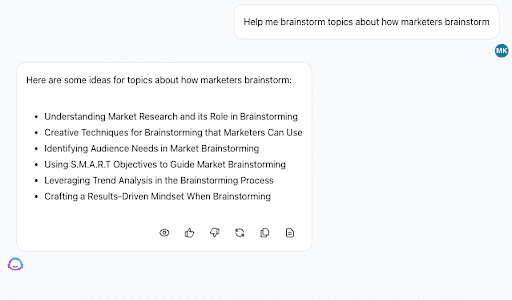
The world is constantly changing, and with it, so is the way we work, communicate, and interact with others.
We’re not just talking about the latest shiny object or social media platform, but the way we think about how we create value.
Take generative AI for example.
A lot of marketers are concerned about the impact that generative AI will have on the marketing industry, and more specifically the role of the content creator or copywriter. However, if we reframe how we think about our roles as marketers, we can start to think about OpenAI’s ChatGPT and other AI content generators as allies rather than enemies.
The key is to embrace the potential benefits of AI and learn how to use it to create value for the businesses and organizations that we serve.
Artificial intelligence will not replace marketers, but marketers who learn to use artificial intelligence to create more value for customers will replace those who don’t.
What is generative AI?
Generative artificial intelligence (AI) refers broadly to a category of algorithms that can be used to create new content, including audio, code, images, text, simulations, and videos. The key word here is “new” – using a type of deep learning, generative AI generates outputs based on the data they have been trained on. So rather than analyzing or acting on existing data, it generates entirely new content based on its inputs.
AI content generators like the ones we use at OTM (ChatGPT and Jasper) can make the content creation process faster and more enjoyable, even for full-time copywriters.
Ways to leverage generative AI as marketers:
Brainstorm topics or ideas
One of our favorite ways to use ChatGPT and Jasper at OTM is for brainstorming topics for blog posts, email campaigns, social media posts, etc. Both platforms can offer topic suggestions based on the keywords you provide.
Here’s an example of us asking Jasper’s chatbot to help us brainstorm topics about brainstorming:

Battle writer’s block or ask for prompts
It can be tough to open a blank page and start writing content. With generative AI, you can put in all of the things you know you want to talk about, including tone of voice and keywords to include, and then leverage the tool to start writing for you.
At OTM, we don’t typically end up using exactly what the tool churns out, but it gives us a starting point that isn’t a blank canvas to get the creative juices flowing.
Quickly ask for and receive feedback
Ask chatbots to provide feedback on your content, not only can they help with clarification, but they can point out ambiguity (it’s all in how you ask!)
Scale and repurpose your content
Leveraging AI tools, you can repurpose content you’ve already created to create additional content such as social media posts in almost no time.
Ask for perspective
When you’ve been writing on one topic for long enough, it can be easy to lose perspective. With chatbots, you can ask for potential counterarguments, which you can then address before ever publishing your content.
How can leveraging generative AI help marketers create more value?
By spending less time staring at a blank canvas or writing really rough drafts, marketers can spend more time on strategy and analysis.
At OTM, we consider ourselves a strategy-first creative agency, and we start every client with our OTM Path to GrowthTM process where we analyze their business and marketing strategy, dive deep into their customer journey, and ultimately create a competitive brand position.
The strategy does not end there, we perform research before beginning any new campaign or project, and we do thorough and ongoing analysis to ensure we’re talking about the right things at the right time, and to the right people. When we have more time to focus on strategy, we find that we can drive more value to the clients that we serve.
Additionally, with the help of a chatbot or AI tool, you can get more done with fewer people. Rather than asking four people to help you brainstorm, you can ask a chatbot. Or rather than take an hour of someone else’s time providing feedback, you can ask ChatGPT.
“According to an analysis by Boston Consulting Group, A.I. can reduce conversion costs by up to 20 percent, with up to 70 percent of the cost reduction resulting from higher workforce productivity.” Source: Inc. Magazine
Are there any challenges that come with AI?
Of course, with any new technology comes misuse and other potential challenges. It’s important to keep these challenges in mind and bring in that “human touch” to make sure you’re always representing your business or your clients in the best way possible.
Content inflation
One of the catches with AI-generated content is that by making content creation easier and faster, language processing AI will have an inflationary effect. It’s like printing money, except the currency is words. This basically means that more content will be produced, making it a more saturated and competitive landscape for content writers to navigate. Search engines will have to adjust to ensure they prioritize content based on quality. But, higher-quality content is good news for marketers!
Tone
AI doesn’t know when it’s tone-deaf because, to a large extent, we flag this sort of thing through intuition. A nuanced appreciation for tone is especially important when talking about something complex or delicate. Everyone has had moments when their finger was hovering over the “Post” button and they felt the tension in their gut. Intuition is driven by biology–and impossible without it.
Logic
AI can’t follow the kinds of complex logic we rely on to create and adjust strategy. This also matters on a more granular level. AI has a very long way to go before it becomes capable of flagging even simple logical fallacies like ad hominem arguments.
Bias
AI can propagate misinformation and harmful stereotypes when not closely monitored because of algorithmic bias, and because it can’t exercise moral reasoning and discernment.
Citations
AI content generators don’t currently cite sources–and presuming that they develop this capability, they probably won’t be adequate at vetting sources for reliability. (You need the capacity for complex logic, as well as occasionally intuition, to do that.) From a credibility standpoint, we must be able to point to sources when we cite specific information that’s not general knowledge. From an ethical standpoint, we must be careful not to represent other people’s ideas as our own.
And remember: human limitations are also assets
The limits of your own perceptions, experiences, and knowledge are also strengths, in their place. Passion, divergent thinking, personal observation, and the ability to redefine (rather than simply “solve”) problems are human attributes that will largely remain out of reach for AI.
What about images?
Outside of AI tools for content creation, there are also AI tools out there for generating images.
That’s for another post, but here’s a quick look at a test we did, generating an image of Max (Kerrie’s Pomeranian) using MidJourney:

What a gentleman.
Summary
The key takeaway from this blog is that generative AI can be extremely useful to marketers, whether your job is to create content or not.
While generative AI cannot produce the marketing strategy that is crucial for any successful business, it can help generate ideas and act as an assistant content creator, freeing marketers up to focus on the overall marketing strategy for their clients or their business.
The future is here and the key is learning how to embrace it, and making sure you’re focused on creating value.
Recommended AI tools to try out yourself:
- ChatGPT
- Jasper and Jasper Chat
- Google Bard
- MS Bing
- Notion now has a new AI feature as well that has our team excited
- MidJourney
